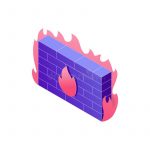Gigabit Ethernet is a digital communications protocol that underlies almost all common networks, including the Internet, and provides a set of rules that govern how data can be packaged and transferred between multiple users without conflict. Gigabit Ethernet applications include gigabit switches that can process data between multiple IP security cameras and network devices, and gigabit switches that support high quality and video transmission between home servers and HDTVs and monitors. All new broadband routers support Gigabit Ethernet along with other traditional computer networking equipment, but Gigabit Ethernet also provides backward compatibility with legacy 100Mbps and 10Mbps Ethernet devices.
Using the Ethernet standard provides the speed required for most applications, but due to the need for higher data consumption and faster speeds, many people want to use 10Gb Ethernet in their LAN. In standard half-duplex mode, Gigabit Ethernet supports 1 Gb/s when using CSMA/CD, but the full-duplex version supports 2 Gb/s in high-speed network backbones.
The ratified IEEE 802.3ab standard defines Gigabit Ethernet transmission over Category 5, 5e, or 6 Unshielded Twisted Pair (UTP) cable and is known as 1000BASE-T. With the ratification of the 802.3ab standard, Gigabit Ethernet became a desktop technology because organizations could use their existing copper infrastructure. The 1997 standard (IEEE 802.3z) required multimode fiber or shielded copper, but two years later, 1000Base-T allowed Gigabit Ethernet (GbE) to run over traditional Category 5 copper There is a network. The IEEE 802.3ab standard defines the suitability of Gigabit Ethernet for 1000 Base T networks and the permitted use of existing UTP cables.
This later gigabit standard became known as 1000BASE-T and opened up the possibility of using 1Gb Ethernet for general use with desktop computers, printers, routers, and Ethernet switches. This upcoming gigabit standard has led to 1Gb Ethernet becoming the standard for copper-based Ethernet connectivity. The more popular 1000BASE-T variant began to be used in 1999 and replaced Fast Ethernet in wired LANs due to its marked speed improvement over Fast Ethernet, and the use of widely available, inexpensive, and standard cables and equipment. .
It is designed for 100 Base T networks and is also compatible with 10 Base T networks, enabling users to benefit from faster Ethernet speeds (using compatible switches) without having to completely upgrade their network systems. Ethernet allows all computers connected to a network to communicate with each other over a single cable.
This technology is typically used to connect devices in a building and is not suitable for networks spanning multiple countries. Ethernet was introduced in the 1990s and follows the IEEE 802.3u standard. Gigabit Ethernet is based on IEEE supported standards and uses the Carrier Sense Multiple Access/Collision Detection (CSMA/CD) protocol to determine when to transmit and what happens if a collision is detected, as well as endpoint addressing, transmission rate, and media.
Fast Ethernet transfer speeds are at least 10 times faster than standard Ethernet, helping maintain compatible connections to high-speed servers, eliminating bandwidth bottlenecks in network systems using multiple IP cameras and IoT, and seamlessly supporting complex networks with multiple A bandwidth-intensive software package. at the same time. Upgrading a standard backbone Ethernet switch to a 100/1000 Mbps Gigabit Ethernet switch is simple and allows you to use Gigabit Ethernet network interface cards (NICs) to connect high-speed server farms. Access layer switches that once provided Fast Ethernet speeds (10-100 Mbps) for end devices or Wi-Fi hotspots now support 1 Gbps and beyond.
Gigabit Ethernet is now the mainstream standard for new devices such as computers, home and small business Internet routers, and Ethernet switches that offer faster speeds than previous versions, enabling Gigabit Ethernet to meet the faster data transfers needed today Require. Known as an upgraded version of the original Ethernet, Fast Ethernet further increased the speed of Ethernet: Ethernet transmission speeds increased from 10 megabits per second (10 Mbps) to 100 megabits per second (100 Mbps). While 1000BASE-T is still used in specific applications where cabling is done by IT professionals, such as IBM BladeCenter using 1000BASE-CX for Ethernet connections between blade servers and switch modules, 1000BASE-T has been successfully used for general copper cabling use.
Cat5e and Cat6e
Cat5e and Cat6 cables are available for speeds up to 5 Gbps and cable lengths up to 100 meters if the gigabit switch supports the IEEE 802.3bz multi-gigabit standard. Fast Ethernet switches are usually equipped with RJ45 ports that run over Cat5 cables to connect PCs, servers, routers, etc. Many Fast Ethernet switches also have high-speed uplink ports where copper/fiber modules can be used to connect fiber or cable UTP. It supports speeds of 1 Gbps or higher.
Many PCs come standard with Gigabit Ethernet, which also means that the network requires the use of Gigabit network switches, routers, etc. However, the fact that standard Cat 5 cables are available for 1000BASE-T variants means that the Ethernet standard will soon replace previous Ethernet options, enabling ever-increasing speeds. Gigabit Ethernet switches typically have multiple RJ45 connectors and/or SFP slots for use with twisted pair copper cables (specifically Cat5e and Cat6 cables that conform to the 1000BASE-T cabling standard) and running SFP optical transceivers on the corresponding type of connecting cable. Network devices provide the same type of RJ-45 connection whether their Gigabit Ethernet ports support 10/100 (fast) or 10/100/1000 (gigabit) connections.
Fiber Optic Transmission
Fiber optic transmission provides longer distances and more bandwidth than UTP cables, allowing network equipment and Fast Ethernet devices to reach their maximum potential. Gigabit Ethernet and 1000BASE-T Gigabit Ethernet, especially in the form of a 1000BASE-T wired connection, provide 1 Gbps data transfer rates, providing high-speed data transmission.
Types of Gigabit Ethernet
| 1000BASE-CX |
| Defined by IEEE 802.3z standard The initial standard for Gigabit Ethernet Uses shielded twisted pair cables with DE-9 or 8P8C connector Maximum segment length is 25 meters Uses NRZ line encoding and 8B/6B block encoding |
| 1000BASE-SX |
| Defined by IEEE 802.3z standard Uses a pair of fiber optic cables of a shorter wavelength having 770 – 860 nm diameter The maximum segment length varies from 220 – 550 meters depending upon the fiber properties. Uses NRZ line encoding and 8B/10B block encoding |
| 1000BASE-LX |
| Defined by IEEE 802.3z standard Uses a pair of fiber optic cables of a longer wavelength having 1270 – 1355 nm diameter Maximum segment length is 500 meters Can cover distances up to 5 km Uses NRZ line encoding and 8B/10B block encoding |
| 1000BASE-T |
| Defined by IEEE 802.3ab standard Uses a pair four lanes of twisted-pair cables (Cat-5, Cat-5e, Cat-6, Cat‑7) Maximum segment length is 100 meters Uses trellis code modulation technique |








